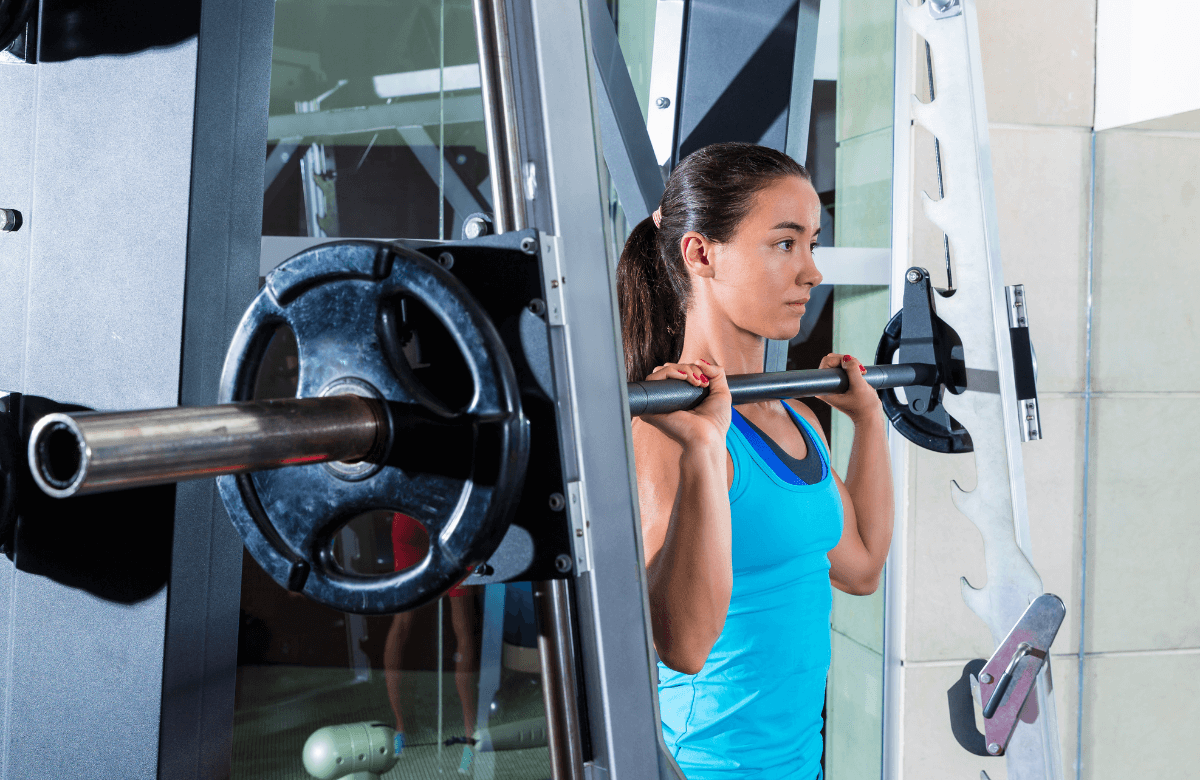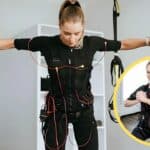Who doesn’t dream of sleeve-popping boulder shoulders? The shoulders play a critical role in an aesthetic physique and daily functioning, making them the focus of many upper body routines.
You might have considered the Smith Machine Shoulder Press in the quest for the best shoulder exercises.
So, is this exercise worth incorporating into your routine? In the article below, we cover everything you need to know, including the benefits, disadvantages, how to perform, and more.
Jump to:
What Is the Smith Machine Shoulder Press?
Let’s start with the fundamentals—what is the Smith Machine Shoulder Press?
The shoulder workout uses the Smith machine to engage the triceps and shoulder muscles, including the front and lateral deltoids.
To perform the exercise, you press the weight directly above your head from shoulder height until the arms are fully extended. The overhead lift can be performed standing or in a seated position.
It’s a variation of the overhead dumbbell and barbell shoulder press. It can also be performed with specialized shoulder press machines.
The Smith machine bar has a linear movement pattern, which can be easier for some lifters. The machine may also be safer, as you can quickly rack the weight if you get too tired. That said, there are some drawbacks to be aware of.
How to Perform Seated Smith Machine Shoulder Press
It’s essential to use the correct technique when performing the seated shoulder press variation. Following the proper protocols will ensure you gain muscle mass while avoiding shoulder injury.
Ensure you use your core strength to maintain a tight torso. Maintain your feet flat on the floor without lifting onto your toes. Lastly, avoid heavier weights until you can perform the correct movement path without any issues or discomfort.
- Take a seat on an upright bench and unrack the Smith machine bar. Bring it down to the starting position near the upper chest.
- Use an overhand grip and push the bar upwards until your arms are straight while breathing out.
- Breathe when you reach the top or while carefully lowering the bar back to chest height.
- Keep doing this exercise for the recommended number of repetitions.
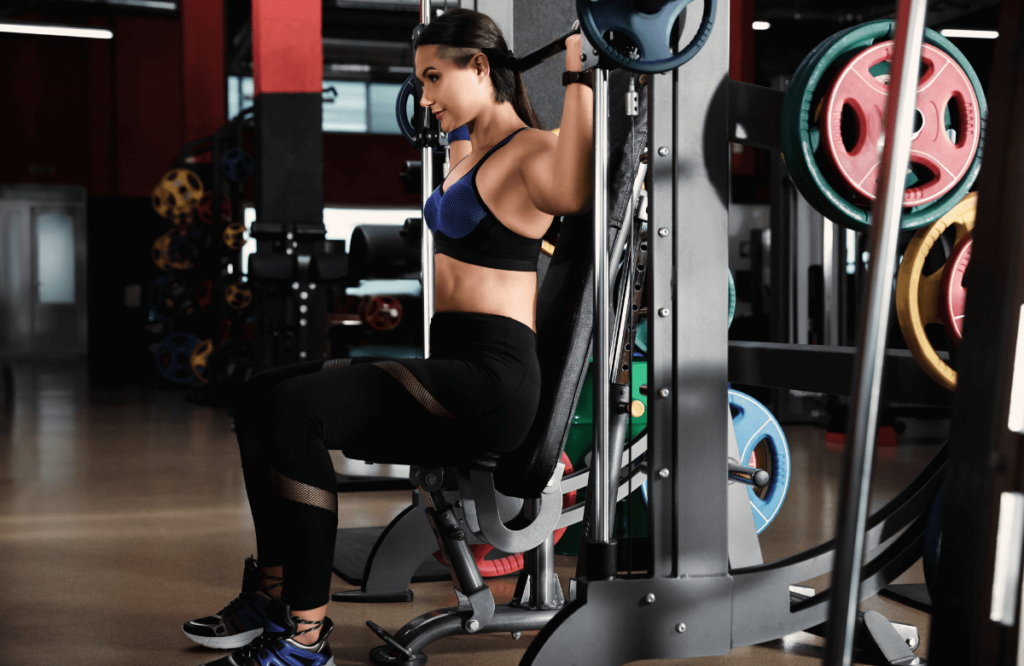
Common Mistakes and Tips
The correct technique is essential in any exercise, especially the Smith machine overhead press. Without the proper form, you’ll find yourself in an awkward stance with tight shoulders and strain on the joints.
- Position correctly: Ensure the bar is positioned right in front of the upper chest. You should be far away, so the bar just misses the nose. Do not sit too far back, as this will compromise the shoulders and strain the area.
- Use the correct hand width: Be sure your hands are comfortable in a slightly wider than shoulder-width position. You will lose strength if your hands are too close together or far apart. Play around with your hand position to find a comfortable, safe grip placement.
- Follow the correct range of motion: It’s essential to press the bar straight up until the arms are fully extended. Missing out on the full range of motion will cause the exercise to be less effective and reduce muscle gains.
Muscles Worked
The Smith machine overhead press is an upper body exercise, primarily engaging the front and side deltoids. The movement uses the triceps as stabilizers when you press the arm above your head and engage the trapezius.
Front and Side Deltoids
The deltoid muscles wrap around the shoulder and are broken into three sections: the anterior, lateral, and posterior deltoid heads. Each muscle head serves a different function but contributes to shoulder movement, stability, and flexibility.
The Smith machine overhead press primarily engages the front and side deltoids.

The front deltoid gets the most engagement, but the side or lateral deltoid is also activated. The rear deltoids don’t get much engagement from the Smith machine shoulder press.
Triceps
The triceps muscle is located on the back of the upper arm and works as a stabilizer during the Smith machine overhead press.
The triceps muscle also comprises three muscle heads—the long, lateral, and medial heads.

The Smith machine shoulder press engages all three portions of the muscle but recruits the long head the most. The triceps are stabilizers in several compound lifts, including bench and overhead presses.
Trapezius
The trapezius, or traps, are slightly engaged during the Smith machine shoulder press. The muscle is located on the upper back, providing your back with thickness. The traps play a role in shoulder mobility, like retracting the shoulder blades or maintaining correct posture.
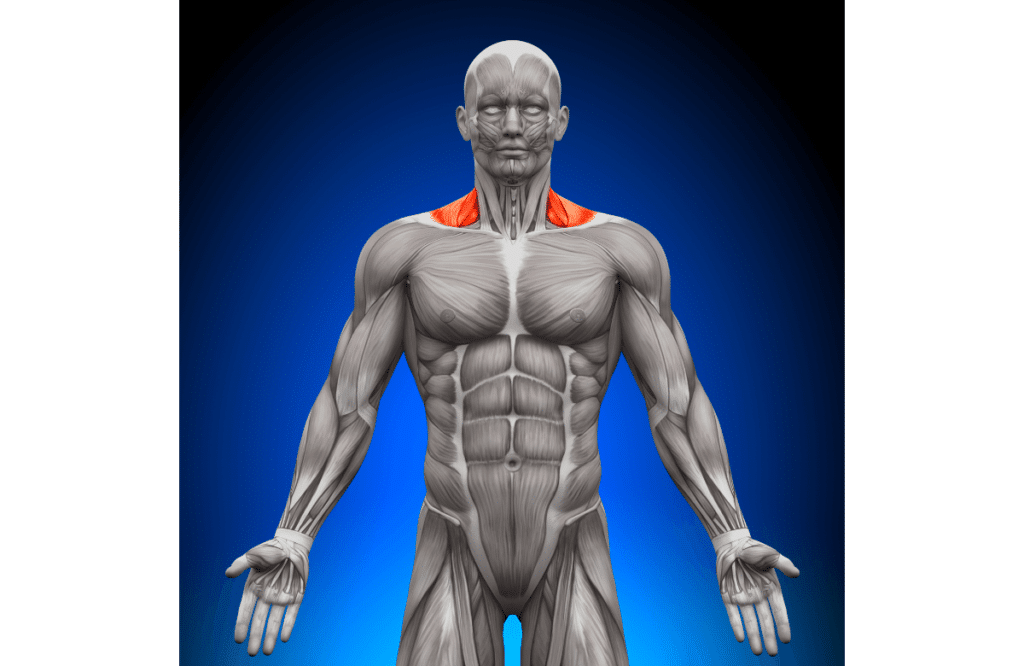
The Benefits of the Smith Machine Shoulder Press
So, why should you incorporate machine shoulder exercises over free-weight shoulder presses? The Smith machine offers several benefits, like reduced lower back stress, more stability, and safer lifts. Here are some of the main advantages of the exercise:
Shoulder Muscle Development
First and foremost, smith machine shoulder workouts can help you develop broader shoulders. The exercise targets the front and side deltoids, alongside the triceps, which contributes to a more athletic upper body.
Besides looking better, strong shoulders can improve your life inside and outside the gym. Increased muscle strength in the shoulder and triceps can improve other lifts, like bench presses.
Daily activities, like lifting boxes overhead or carrying groceries, may also improve as your upper body gets stronger.
Healthy Shoulders
The shoulder joint is one of the most complex parts of the human body. It has several muscles, ligaments, tendons, and bones that work together to move the arm. The shoulder joint is also prone to injury and strain.
Training the muscles with machine exercises can help you develop stable shoulders. All areas of your life will improve with more shoulder strength, stability, and mobility.
Reduced Lower Back Stress
Compared to conventional shoulder press exercises, the Smith machine provides additional support for the lower back. The fixed bar path helps stabilize your torso, minimizing the need for core and lower back strength.
Less pressure on the lower back can be advantageous if you have previous injuries or lower back issues. It’s also helpful if you want to focus solely on the shoulder muscles.
Stability, Safety, and Control
The Smith machine provides lifters with more stability, safety, and control.
The guided barbell movement requires less support from the core and stabilizing muscles, making it easier for new lifters. Most machines use fixed vertical planes to restrict excessive lateral movement, reducing the chance of injury.
The Smith machine also has a “built-in” spotter. You can quickly re-rack the weight if you can’t lift it or use the safety stops to avoid injury. These safety latches and mechanisms are beneficial for heavy shoulder days or if you’re new to the gym.
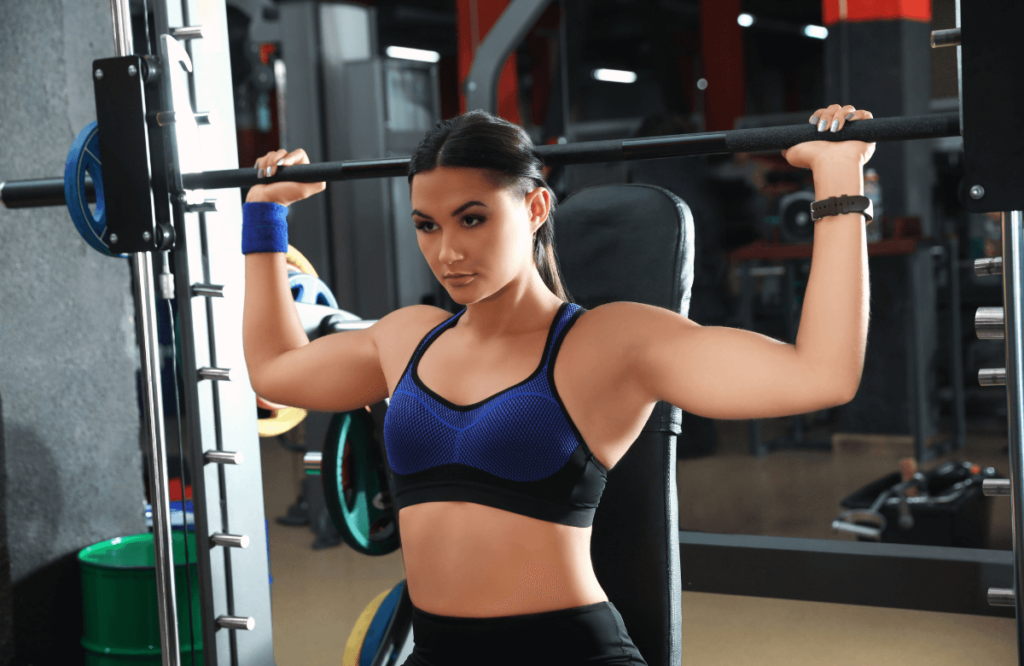
Convenience
The Smith machine makes a convenient option for nearly any shoulder workout routine. With safety latches, easy-to-load weights, and a variety of exercises, you can quickly create a well-rounded upper-body regimen.
Most commercial gyms and even apartment gyms have a Smith machine, making them readily available.
You can also set the bar to your preferred height, as there are several notches and slots available. Without the need for a spotter, you can perform heavy lifts on your own without much risk of dropping the weight or injury.
The Disadvantages of the Smith Machine Shoulder Press
Although there are some awesome benefits to the Smith machine, there are some drawbacks to be aware of. Some of the same reasons that make the Smith machine an effective tool for developing the shoulders are the same reasons why it should be avoided. Here’s what you need to know:
Fixed Movement Path
The Smith machine’s fixed movement path is a double-edged sword—it’s beneficial for some applications and disadvantageous for others.
The Smith machine’s bar only travels vertically, limiting forward/backward motion. This design can restrict your form, as standard compound exercises will have a bit of forward/backward movement.
This can put you in an awkward position with a range of motion that feels unnatural. In some cases, the restricted movement can place additional stress on the joints leading to injury or strain.
Doesn’t Recruit as Many Muscles
One of the downsides of the Smith machine is that it doesn’t recruit as many muscles, making it less suited for muscle gains.
The narrow bar path makes certain lifts easier, as you don’t have to use as many stabilizer muscles. One study found the Smith machine used fewer supporting muscles compared to free-weight bench presses.
This can be advantageous in some applications, like isolating a muscle group or for those with injuries. But if maximal gains are your priority, it may be better to stick with free-weight barbell shoulder workouts.

Smith Machine Shoulder Press Variations and Alternatives
If you don’t have access to a Smith machine or want to switch up your routine, there are alternative options available. Incorporating alternative shoulder movements will challenge your muscles, recruit different muscle fibers, and keep your gym routine fresh.
1. Barbell Shoulder Press
The Barbell Overhead Press is a foundational compound lift for developing the upper body. It’s one of the most effective shoulder exercise variations for targeting the front and lateral deltoid muscles alongside the triceps.
The barbell overhead press is also used in powerlifting, strongman, and CrossFit competitions.
- Start by placing a barbell on a rack at chest height.
- Hold the bar with your hands slightly wider than your shoulders and stand close to it.
- Take a deep breath and tighten your core muscles. Lift the bar off the rack.
- Move back a little and let the bar rest on the front of your shoulders.
- Exhale as you push the bar up until your arms are straight.
- Inhale either when you reach the top or as you slowly bring the bar down to your shoulders.
- Repeat these steps for the desired number of repetitions.
The benefit of the free weight variation is that it incorporates more stabilizing muscles compared to the Smith machine. You have to maintain a tight core to keep your body stable and rely on the triceps more. This makes the movement more advantageous for developing functional strength.
2. Dumbbell Shoulder Press
The Dumbbell Shoulder Press is a go-to movement for many gym goers, and for a good reason—it trains each side independently, helps with muscle imbalances, and requires more stabilizing muscles.
- Stand upright with your feet shoulder-width apart.
- Hold a dumbbell in each hand and raise them up to shoulder height, with the palms facing away from you.
- Take a deep breath and engage your core muscles.
- Push the dumbbells upward toward the ceiling as you breathe out, making sure to keep your arms straight.
- Take a breath when you reach the top of the movement, and slowly lower the weights down to the starting position.
- Repeat this motion for the number of repetitions you want to achieve.
With two-handed exercises, like with the Smith machine or barbell, it’s common for your stronger arm to take the brunt of the work. Dumbbell variations eliminate this problem, as each arm has to raise the weight independently.
3. Push Press
If you want to forgo machines and seated variations altogether, check out the Push Press. This movement is similar to the strict press but incorporates a slight bend in the knees for added momentum. The extra momentum allows you to press more weight and gain more muscle strength.
- Start by placing a barbell on a rack at chest height.
- Hold the bar with your hands slightly wider than your shoulders and stand close to it.
- Take a deep breath and tighten your core muscles. Lift the bar off the rack.
- Move back a little and let the bar rest on the front of your shoulders.
- Now, bend the legs into a quarter squat stance.
- Use the momentum from your legs to press the bar directly overhead.
- Inhale either when you reach the top or as you slowly bring the bar down to your shoulders.
- Repeat these steps for your desired rep range.
The Push Press incorporates the lower body into the overhead press to help you lift heavy weights. It’s better to focus on pressing the weights up with the legs rather than just the upper body. Taking some time to learn the technique with lighter weights will help you get the most out of this movement and reduce the chance of strain.
4. Behind the Neck Overhead Press
One overhead lift that often gets overlooked is the Behind the Neck variation. Instead of positioning the weight in front of your body, you place it behind the neck. This engages the lateral and rear deltoids more while challenging the stabilizing muscles.
- Hold the barbell with a grip slightly wider than your shoulders and position it against the base of your neck.
- Take a deep breath, tighten your core, and lift the bar off its rack. Step back slightly.
- Push the bar upward until your arms are fully extended while breathing out.
- Inhale either at the top of the movement or as you slowly lower the bar down to the base of your neck.
- Repeat this process for the desired number of repetitions.
The behind-the-neck overhead press does require a bit more shoulder mobility than the traditional exercise. It can be helpful for improving your range of motion and stability, but starting with a lighter weight is recommended.
5. Dumbbell Front Raise
If you’re looking for exercises to isolate the deltoids, try the Front Dumbbell Raise. The Smith machine shoulder press engages the front deltoids, so this can be a great addition to your routine to target the same area.
- Grab a dumbbell in both hands with the palms facing your thighs and your arms in front of your thighs.
- Lift the dumbbells slowly in a straight line, keeping your arms straight until they reach shoulder height.
- Lower the weights down slowly to the starting position to complete one repetition.
- Repeat this motion for the number of repetitions you desire.
It’s best to use lighter weights during isolation movements. Excessive weight can strain the muscle and cause you to use other muscles to complete the reps. Instead, focus on maintaining control and building fatigue in the muscles. Weights in the 8–12 rep range are ideal.
6. Dumbbell Lateral Raises
Another way to isolate the lateral delt is to perform Dumbbell Lateral Raises. This movement can enhance shoulder stability and help you build a larger frame. It’s a unilateral exercise, so each side is challenged independently, which can also help with muscle imbalances.
- Grab a dumbbell in each hand with your arms at your sides and your palms facing your thighs.
- Raise the dumbbells out to your sides slowly until your arms are horizontal and the dumbbells reach shoulder height.
- Lower the dumbbells down slowly to the starting position to complete one repetition.
- Repeat this motion for the number of repetitions you want to achieve.
Like the front raise, it’s best to use lighter weights you can perform comfortably for three sets of 8–15 reps. Going too heavy may compromise your form or strain the shoulder joint.
Frequently Asked Questions (FAQ)
Is the Smith Machine Good for Shoulder Press?
The Smith machine can be fantastic for the shoulder press, but it does have some downsides. It offers more stability than traditional exercise but doesn’t engage the stabilizer muscles as much. The restricted bar path can also place the shoulder in an uncomfortable or compromised position. It’s essential to use the correct form, manageable weights, and warm up ahead of time.
Is It OK to Do Overhead Press on Smith Machine?
Yes, it’s OK to do the overhead press on the Smith machine. The piece of equipment does have drawbacks compared to the conventional barbell or dumbbell variation, but this doesn’t mean it’s entirely useless. Be sure to practice the correct technique and use manageable weights that are challenging without sacrificing form.
What Is the Difference Between Seated Smith Machine Shoulder Press and Barbell?
The Smith machine has a fixed bar path, meaning the bar only travels vertically without any horizontal movement. This can be unnatural or uncomfortable for some lifters. It also engages stabilizing muscles less, which can be beneficial if you want to isolate the shoulders.



